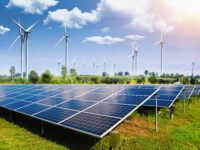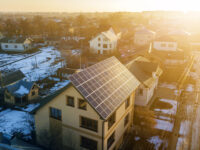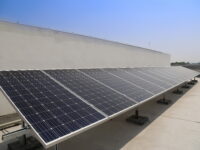Solar is becoming more and more popular. There’s still a lot of equipment needed, and it’s going to take up a lot of space on something like a rooftop. There have been a lot of ideas about how to avoid that problem from people all over the world. Some people build solar panels into flat surfaces, like roads and Tesla roof tiles. When you think about transparent solar panels. It’s exciting because you could turn every window (or even your phone screen) into a source of energy!
Isn’t that great? Some of the stories and viral social media posts we’ve seen about transparent solar over the years have turned out to be way overblown or too early in the process. So, what’s going on with the transparent solar market? Many future tech things sound great in movies but won’t happen in our lifetimes. Is this one of them, or are we close to making it happen?
Summary:
- Transparent solar isn’t ready for use in homes yet, and it may be years before it’s used in homes.
- People have already tried the technology. And it works, but it is only about a third as efficient as traditional solar.
- Research teams worldwide are working on transparent solar, and some have had some commercial success.
- It’s not very common to see transparent solar panels used in homes or businesses.
- It’s not clear how transparent solar panels are except for a test in Korea. And there is a trade-off between transparency and how much power they make.
- Studies have shown that transparent panels can grow plants in greenhouses despite not being completely transparent.
- Solar panels built into window blinds are another option that isn’t as risky.
Transparent Solar Panels Theory
For people who know even a little about how solar panels work. The idea of a transparent solar panel might seem crazy. Solar panels take in solar energy and turn it into electricity. How can a panel simultaneously take in solar energy and let it pass through? Capture the unseen UV spectrum while allowing the apparent spectrum to pass through.
In theory, researchers say that because transparent panels could replace old windows. They could make up for the lack of efficiency by adding more space to the room. Some experts say that the U.S. has 5-7 billion square meters of windows. 2.5 billion square meters of glass adding to the world’s windows every year. But the truth is more complicated. And teams worldwide have come up with many ways to make that seemingly simple idea work.
Also Read:
Buying Guide: 10 Best Portable Solar Panel in 2022: Reviews and Tips
Guide to Polycrystalline Solar Panel: Features, Operation, and Applications
Energy That Is Always Available
In the United States, two men work on transparent solar technology: Vladimir Bulova, a professor at MIT, and Richard Lunt, a professor at Michigan State University. Both men started their careers at MIT before moving to Michigan. In 2015, Lunt showed off the technology at MSU.
Along with Miles Barr, they started Ubiquitous Energy to make money from the new technology. Solar panels made by this company claim to be the only genuinely transparent ones in the world. They are only 40% to 80% transparent, with up to 10% efficiency, even though the company says that they are (the best solar panels today have about 23 percent efficiency).
It has been around for a while, but Ubiquitous Energy only has two public installations: its headquarters in Redwood City, Calif., and a plant in Northwood, Ohio. The company says there will be a few more installations shortly, including one at a prominent place. If you want to buy glass or glazing for commercial use, the NSG Group is one of the best places to buy it. NSG Group is a group of companies termed the Nippon Sheet Glass Co. Ltd.
In 2019, Ubiquitous Energy and NSG teamed up to put UE’s ClearView Power solar coating on glass in buildings. The partnership makes sense since Pilkington makes glass for solar panels and solar control glass, protecting people inside a building from sunlight. Ubiquitous Energy and Antamex have just announced that they will work together to add solar glazing to architectural windows.
Down Under, ClearVue
On the other side of the world, ClearVue in Australia has more public information about its installations and how many people use them. The film has two layers of glass that direct light to solar cells in the window frame. In West Perth, ClearVue has a showroom to see the clear panels in use.
ClearVue’s windows have been used in universities, high-end villas, and the Warwick Shopping Centre Atrium. ClearVue says it produces about 1.6 kWh per day from 25 square meters of window space, which is about the size of a football field. And that’s even after the battery and DC-to-AC losses are taken into account, which is pretty cool.
ClearVue admits that a traditional solar panel that is 22% efficient if placed in the right way can produce six times more energy than its clear panels. About $400 per sq/meter (in American dollars) doesn’t include framing and installation. ClearVue windows are made by a company called ClearView.
It costs about $14 per square foot in the United States to buy non-solar low-E windows that don’t have any solar power. There are about 10.8 sq/feet in an sq/meter, so to cover a square meter with a typical low E would cost about $150 or about $250 less than ClearVue. ClearVue says that the extra money can be paid back as little as a year, and the panels last about 20 years.
Korean Transparent Solar Panels

Before this year, Professor Joondong Kim of Incheon National University said a breakthrough in transparent solar technology was a transparent solar panel. This is the first transparent solar panel. Professor Kim’s method is to put titanium dioxide or nickel oxide right into the glass to make it absorb solar energy. Both are very clear to the eye. Titanium dioxide is previously used in solar cells and is suitable for the environment.
On the other hand, nickel oxide is plentiful and cheap to make. Prof. Kim thinks that the cells could make phone screens because the panels are transparent. On the other hand, the cells aren’t likely to be used for years, and they only work at 2.1 percent efficiency. Given that they’re clear, they’re impressive. But a phone doesn’t have as much glass as a skyscraper, so it’s unclear how much battery life the panels would help.






